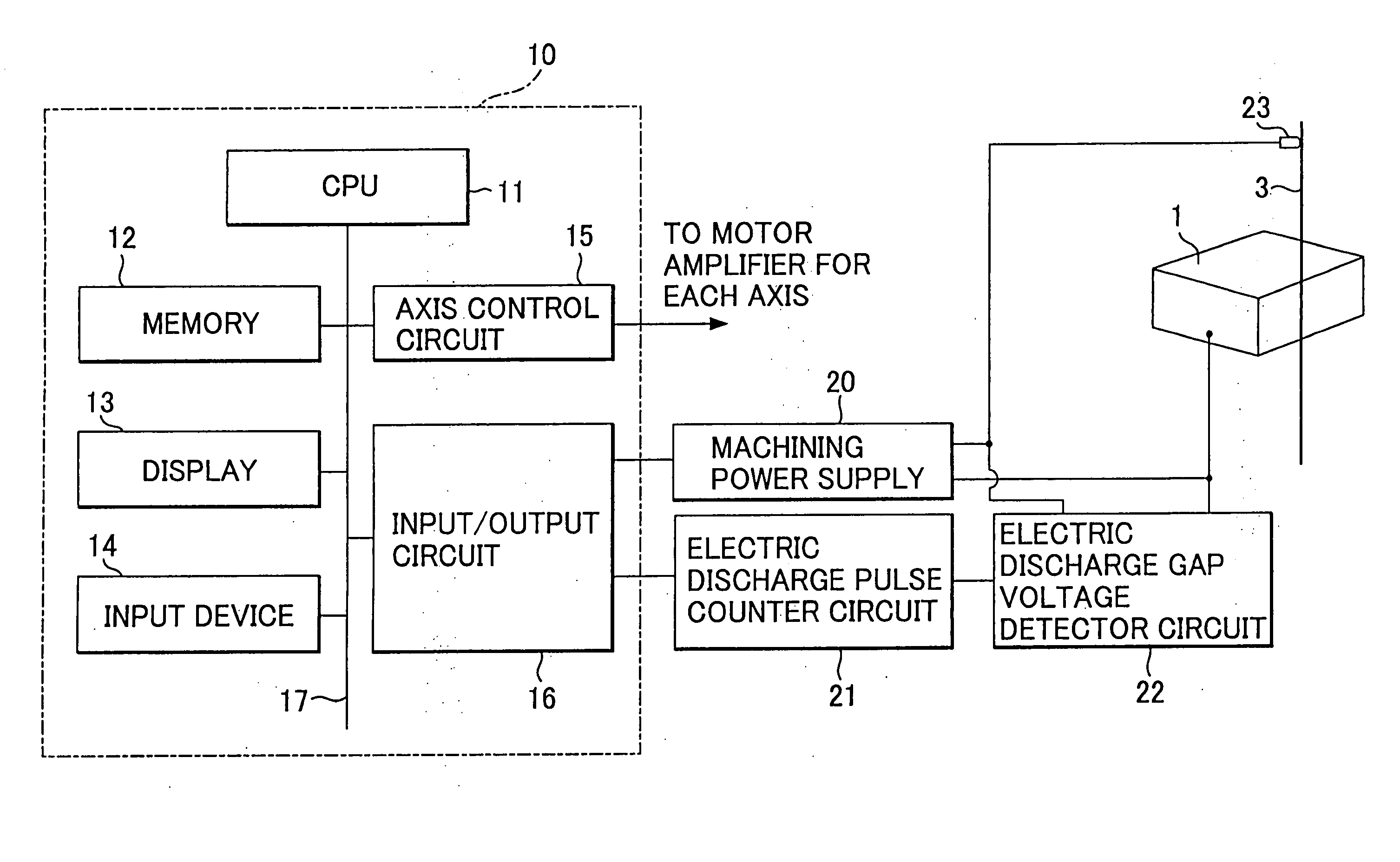Machining control method for wire-cut electric discharge machine
- Summary
- Abstract
- Description
- Claims
- Application Information
AI Technical Summary
Benefits of technology
Problems solved by technology
Method used
Image
Examples
first embodiment
[0034] First, the finish machining is started based on conventional axis feed speed constant control. Based on the machining programs, as in the conventional case, the movement commands to the axes are obtained every control period. According to the present invention, moreover, a path correction process shown in FIG. 5 is carried out.
[0035]FIG. 5 is a flowchart showing the path correction process according to the first embodiment of the invention. The processor 11 reads an electric discharge pulse number N(t) from the electric discharge pulse counter circuit 21 and then resets a counter for counting the electric discharge pulses (Step 100). By multiplying by a gain G1 a value obtained by subtracting the read electric discharge pulse number N(t) from a preset target electric discharge pulse number Ng, a correction value ΔP1(t) is obtained (Step 101).
[0036] Then, the direction normal to the path of movement of the wire electrode is obtained in accordance with the movement command tha...
second embodiment
[0042] In the case of the second embodiment, as described above, the correction value ΔP2(t) for the movement command is proportional to the value that is obtained by adding up the deviations between the detected electric discharge pulse number N(t) and the target electric discharge pulse number Ng. Therefore, the correction value ΔP2(t) never changes suddenly but smoothly, so that satisfactory machining stability can be obtained, and the machined surface can enjoy uniform roughness.
[0043]FIG. 7 is a flowchart showing a path correction process according to a third embodiment of the present invention. In this third embodiment, control is carried out with based on an average machining voltage, not on an electric discharge pulse number. In carrying out the third embodiment, the electric discharge pulse counter circuit 21 shown in FIG. 4 is replaced with an average machining voltage calculator circuit.
[0044] The processor 11 reads an average machining voltage V(t) from the average mach...
third embodiment
[0046] In the case of the third embodiment, as described above, the correction value ΔP3(t) for the movement command is proportional to the value that is obtained by adding up the deviations between the detected average machining voltage V(t) and the target average machining voltage Vg. Therefore, the correction value ΔP3(t) never changes suddenly, so that stable machining voltage can obtained. Thus, even if the machining voltage must be used in place of the electric discharge pulse number in consideration of special circumstances, definite effects, such as good machining stability and uniform surface roughness, can be enjoyed.
[0047] In each of the embodiments described herein, the normal direction is obtained in Step 102, 203 or 303. Alternatively, however, an offset process may be carried out to move the wire electrode 3 relatively to the workpiece 1 along the path instructed by the machining program with a given gap between the electrode and the workpiece. In this offset process,...
PUM
| Property | Measurement | Unit |
|---|---|---|
| Speed | aaaaa | aaaaa |
Abstract
Description
Claims
Application Information
 Login to View More
Login to View More - R&D
- Intellectual Property
- Life Sciences
- Materials
- Tech Scout
- Unparalleled Data Quality
- Higher Quality Content
- 60% Fewer Hallucinations
Browse by: Latest US Patents, China's latest patents, Technical Efficacy Thesaurus, Application Domain, Technology Topic, Popular Technical Reports.
© 2025 PatSnap. All rights reserved.Legal|Privacy policy|Modern Slavery Act Transparency Statement|Sitemap|About US| Contact US: help@patsnap.com



